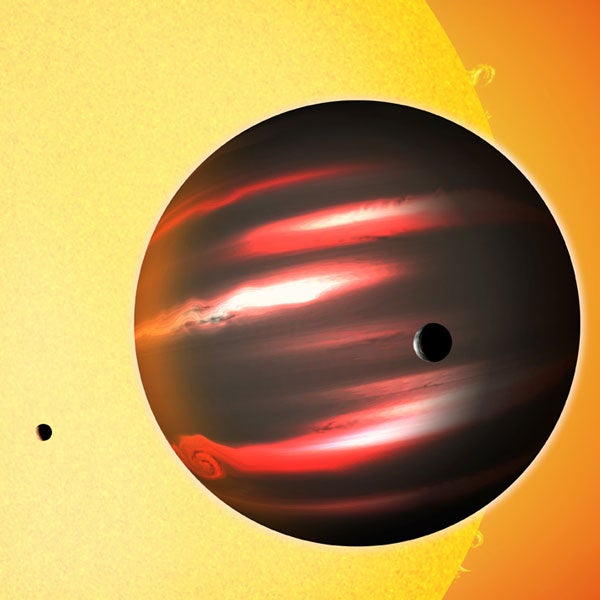“TrES-2b is considerably less reflective than black acrylic paint, so it’s truly an alien world,” said David Kipping from the Harvard-Smithsonian Center for Astrophysics in Cambridge, Massachusetts.
In our solar system, Jupiter is swathed in bright clouds of ammonia that reflect more than a third of the sunlight reaching it. In contrast, TrES-2b, which was discovered in 2006 by the Trans-Atlantic Exoplanet Survey (TrES), lacks reflective clouds due to its high temperature.
TrES-2b orbits its star at a distance of only 3 million miles (5 million kilometers). The star’s intense light heats TrES-2b to a temperature of more than 1800° Fahrenheit (980° Celsius) — much too hot for ammonia clouds. Instead, its exotic atmosphere contains light-absorbing chemicals like vaporized sodium and potassium, or gaseous titanium oxide. Yet none of these chemicals fully explain the extreme blackness of TrES-2b.
“It’s not clear what is responsible for making this planet so extraordinarily dark,” said David Spiegel from Princeton University in New Jersey. “However, it’s not completely pitch black. It’s so hot that it emits a faint red glow, much like a burning ember or the coils on an electric stove.”
Kipping and Spiegel determined the reflectivity of TrES-2b using data from NASA’s Kepler spacecraft. Kepler is designed to measure the brightness of distant stars with extreme precision. The team monitored the brightness of the TrES-2 system as the planet orbited its star. They detected a subtle dimming and brightening due to the planet’s changing phase.
Scientists believe TrES-2b is tidally locked like our Moon, so one side of the planet always faces the star. And like our Moon, the planet shows changing phases as it orbits its star. This causes the total brightness of the star plus planet to vary slightly.
“By combining the impressive precision from Kepler with observations of over 50 orbits, we detected the smallest-ever change in brightness from an exoplanet: just 6 parts per million,” said Kipping. “In other words, Kepler was able to directly detect visible light coming from the planet itself.” The extremely small fluctuations proved that TrES-2b is incredibly dark. A more reflective world would have shown larger brightness variations as its phase changed.
Kepler has located more than 1,200 planetary candidates in its field of view. Additional analysis will reveal whether any other unusually dark planets lurk in that data.
TrES-2b orbits the star GSC 03549-02811, which is located about 750 light-years away in the direction of the constellation Draco.
“TrES-2b is considerably less reflective than black acrylic paint, so it’s truly an alien world,” said David Kipping from the Harvard-Smithsonian Center for Astrophysics in Cambridge, Massachusetts.
In our solar system, Jupiter is swathed in bright clouds of ammonia that reflect more than a third of the sunlight reaching it. In contrast, TrES-2b, which was discovered in 2006 by the Trans-Atlantic Exoplanet Survey (TrES), lacks reflective clouds due to its high temperature.
TrES-2b orbits its star at a distance of only 3 million miles (5 million kilometers). The star’s intense light heats TrES-2b to a temperature of more than 1800° Fahrenheit (980° Celsius) — much too hot for ammonia clouds. Instead, its exotic atmosphere contains light-absorbing chemicals like vaporized sodium and potassium, or gaseous titanium oxide. Yet none of these chemicals fully explain the extreme blackness of TrES-2b.
“It’s not clear what is responsible for making this planet so extraordinarily dark,” said David Spiegel from Princeton University in New Jersey. “However, it’s not completely pitch black. It’s so hot that it emits a faint red glow, much like a burning ember or the coils on an electric stove.”
Kipping and Spiegel determined the reflectivity of TrES-2b using data from NASA’s Kepler spacecraft. Kepler is designed to measure the brightness of distant stars with extreme precision. The team monitored the brightness of the TrES-2 system as the planet orbited its star. They detected a subtle dimming and brightening due to the planet’s changing phase.
Scientists believe TrES-2b is tidally locked like our Moon, so one side of the planet always faces the star. And like our Moon, the planet shows changing phases as it orbits its star. This causes the total brightness of the star plus planet to vary slightly.
“By combining the impressive precision from Kepler with observations of over 50 orbits, we detected the smallest-ever change in brightness from an exoplanet: just 6 parts per million,” said Kipping. “In other words, Kepler was able to directly detect visible light coming from the planet itself.” The extremely small fluctuations proved that TrES-2b is incredibly dark. A more reflective world would have shown larger brightness variations as its phase changed.
Kepler has located more than 1,200 planetary candidates in its field of view. Additional analysis will reveal whether any other unusually dark planets lurk in that data.
TrES-2b orbits the star GSC 03549-02811, which is located about 750 light-years away in the direction of the constellation Draco.










